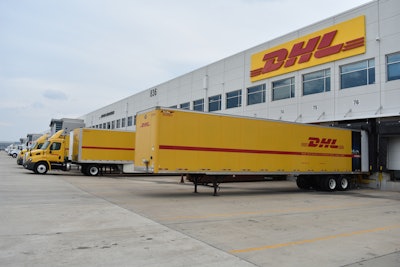 DHL trucks are docked at a DHL Global Forwarding facility near Chicago’s O’Hare airport to deliver imported shipments.
DHL trucks are docked at a DHL Global Forwarding facility near Chicago’s O’Hare airport to deliver imported shipments.CCJ Innovators profiles carriers and fleets that have found innovative ways to overcome trucking’s challenges. If you know a carrier that has displayed innovation, contact CCJ Editor Jason Cannon at [email protected] or 800-633-5953.
Fifty years ago, in September 1969, three business partners in San Francisco (Dalsey, Hillblom and Lynn) had an idea to send cargo paperwork to Honolulu by plane before containers arrived by ship. They started a niche service, DHL, that expanded rapidly by allowing the processing of cargo to start before its arrival.
More recently, business growth for the global logistics provider, Deutsche Post DHL Group, has been driven by globalization and by e-commerce, which represents 90 percent of all retail growth.
Overall, the DHL Group has 550,000 employees worldwide. In the Americas, the company operates four business units: DHL Supply Chain, DHL Global Forwarding, DHL Express and DHL eCommerce Solutions.
For its next wave of growth, DHL Group is fueling the digitalization of the supply chain. A study by global consulting group McKinsey predicts that digital innovation will account for two-thirds of revenue and three-fourths of profit growth for supply chain companies.
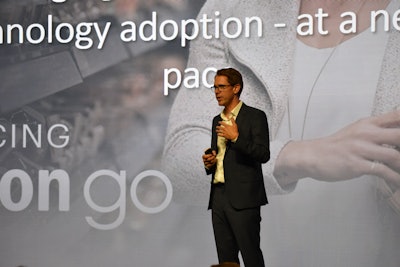 Matthias Heutger, global head of innovation for DHL Group, leads a team that researches key trends and opportunities the company invests in.
Matthias Heutger, global head of innovation for DHL Group, leads a team that researches key trends and opportunities the company invests in.Since 2012, digital innovation in supply chain logistics has been the biggest focus of venture capital with an estimated $30 billion in investments made in startups, says Matthias Heutger, the company’s global head of innovation.
“The industry is hotter than ever,” he says.
Digital supply chain
DHL Supply Chain is the largest third-party contract logistics provider (3pl) in North America with 485 warehousing and logistics sites in operation for its diverse base of 284 customers.
In North America, the business unit has a dedicated fleet of more than 2,000 power units and 3,000 trailers and also sources capacity from carriers. Using its own fleet and external capacity for transportation solutions account for 20 percent of the unit’s overall revenue, says Scott Sureddin, chief executive of DHL Supply Chain.
In September, DHL Supply Chain announced a new partnership with Convoy to be the first 3pl to integrate Convoy’s digital freight network of carriers and pricing information into a supply chain application.
In tandem with this announcement, it also announced a partnership with Turvo to add its real-time collaborative logistics platform to give all parties in freight transactions shared visibility to take action on the same information at the same time.
Convoy’s digital freight network and the Turvo platform are being integrated with MySupplyChain, DHL’s proprietary end-to-end visibility and business intelligence platform to give its customers a single web-based portal for accessing all order and supply chain information, from warehousing to final delivery.
The MySupplyChain platform makes it easy for customers to access track and trace information, product inventory, and view operational performance reporting and analytics. They can also contact customer service and retrieve documents.
By using the technology — via the secure website, app or APIs that integrate directly with their office systems — its customers have real-time visibility of an order from when it is picked at a warehouse through the final delivery, says Mike Kreider, vice president of IT Americas.
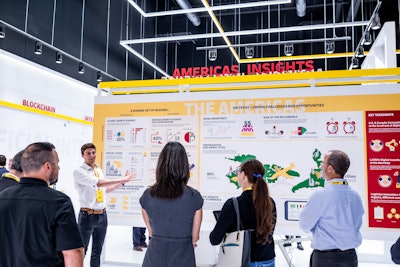 At the DHL Innovation Center in Rosemont, Chicago, customers and business partners of DHL learn about new and emerging technologies and trends.
At the DHL Innovation Center in Rosemont, Chicago, customers and business partners of DHL learn about new and emerging technologies and trends.More than a self-service customer portal or app, MySupplyChain is a big data platform that allows DHL to take events coming from its warehouses, transportation providers and updates from customer ERP systems to bring “data together to get one single view for our customers to capture exactly what is going on in their supply chain,” he says.
Robotics automation
Another new advancement in DHL Supply Chain’s digitization strategy is the expansion of robotics process automation (RPA) into everyday operations. RPA describes software algorithms that work as self-learning “bots” that are programmed to do tasks across multiple applications, just like humans.
DHL Supply Chain has been using RPA for a couple years to automate repetitive tasks such as collecting documents for proof of delivery, scheduling loads, event tracking and reducing manual error and increasing speed.
To date, in North America the company has offset over 5,000 hours of manual work with RPA, and globally has saved more than 31,200 hours per year during pilot projects.
“Before RPA, many basic, day-to-day tasks would need to wait to be completed until capacity allowed. Now they are done quickly and with a high level of accuracy, freeing our employees to spend less time doing busy work and more time doing the strategic value-added work they enjoy,” said Jim Monkmeyer, president, transportation, DHL Supply Chain, North America.
Besides using software automation tools, DHL Supply chain is using mechanical robots in its warehouses to solve labor challenges.
“We have been on journey probably for the past three to four years on digitalization and we are rapidly using technology to automate manual processes,” says Sally Miller, chief information officer of DHL Supply Chain. The company has deployed several hundred “assistant picking robots” at locations in North America that are working alongside humans to improve efficiency and accuracy. “We are finding that technology is very good to offset peak labor needs and working with associates to improve productivity.”
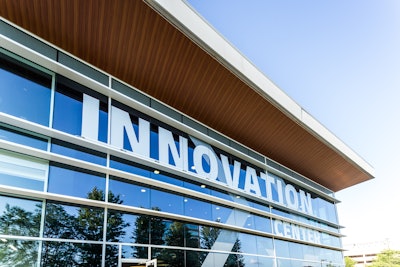 The DHL Group opened a new Innovation Center, the third of its kind worldwide, in Rosemont, Chicago in September.
The DHL Group opened a new Innovation Center, the third of its kind worldwide, in Rosemont, Chicago in September.One of the most recent technologies being used in its warehouses began in 2015 by using Google Smart glasses for order picking. Warehouse workers using the glasses have shown a 14 to 20 percent increase in productivity and up to 15 percent decrease in training time.
The Innovation Center
On Thursday, Sept. 12, global logistics provider Deutsche Post DHL Group held a grand opening of a newly constructed DHL Innovation Center in Rosemont, Ill.
DHL expects 5,000 supply chain professionals will be visiting the new facility every year to discuss ideas and watch demonstrations of technology that has the potential for significant productivity and efficiency gains.
The state-of-the-art 28,000 square-foot facility in Rosemont is organized into three areas: a workshop, showroom and networking space. In each, DHL employees can interact and engage with customers, technology partners, academics and other DHL associates to demonstrate and discuss solutions to supply chain challenges.
The company has established a process for determining which technologies it will showcase in the Innovation Center in advance of deploying them to select customers as proof-of-concepts before scaling out.
The process starts with DHL creating a report every other year called the Logistics Trend Radar. The report, now in its fourth year, looks at trends that company leaders believe will impact the industry in the next five to 10 years.
The report gives DHL a structured way to understand societal and technology trends in its business environment by ranking them according to their predicted impact and time horizon. Each year, the company picks two or three of the topics and does a separate “deep dive” trend report.
Topics in the deep-dive report become DHL’s near-term strategic roadmap for investments and partnerships. Technology solutions that it finds to be workable are showcased in its Innovation Center to engage with customers and build use cases, Heutger says.
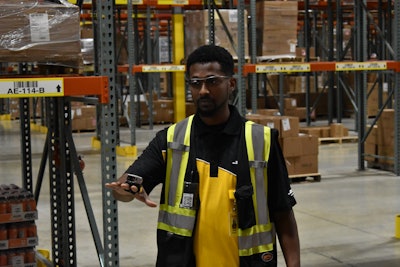 DHL Supply Chain is using new “quick pick” technology such as ring scanners and smart glasses to increase worker productivity and accuracy in its contract warehouses.
DHL Supply Chain is using new “quick pick” technology such as ring scanners and smart glasses to increase worker productivity and accuracy in its contract warehouses.As an example, the company’s investment in artificial intelligence (AI) for robotics started with a deep-dive trend report in 2016. A use case was developed for a real-time shipment weight and dimensioning technology that is three to four-times less costly than laser scanning.
That technology is now being used on a limited basis in DHL facilities and is currently in the process of being scaled out. A DHL Global Forwarding facility near Chicago is beginning to use the technology to scan freight as it is pulled from inbound containers and trailers to have accurate invoicing and customs processing.
The new DHL Innovation Center in the Chicago area was built for the company’s operations in the Americas and joins two nearly identical facilities in Cologne, Germany, and Singapore for the company’s European and Asian operations, respectively.
Chicago is also an important airfreight hub for the DHL Group. The company’s DHL Express division plans to take air cargo volume going to its main Cincinnati hub and route it through Chicago’s O-Hare airport (ORD). It plans to soon have airfreight shipments come directly to ORD from Leipzig, Germany, and from Asia via New York. Exports will go from Chicago to Asia via Incheon South Korea.




![Reddaway[1]-2019-08-24-11-01](https://img.ccjdigital.com/files/base/randallreilly/all/image/2019/08/ccj.Reddaway1-2019-08-24-11-01.png?auto=format%2Ccompress&fit=crop&h=167&q=70&w=250)








